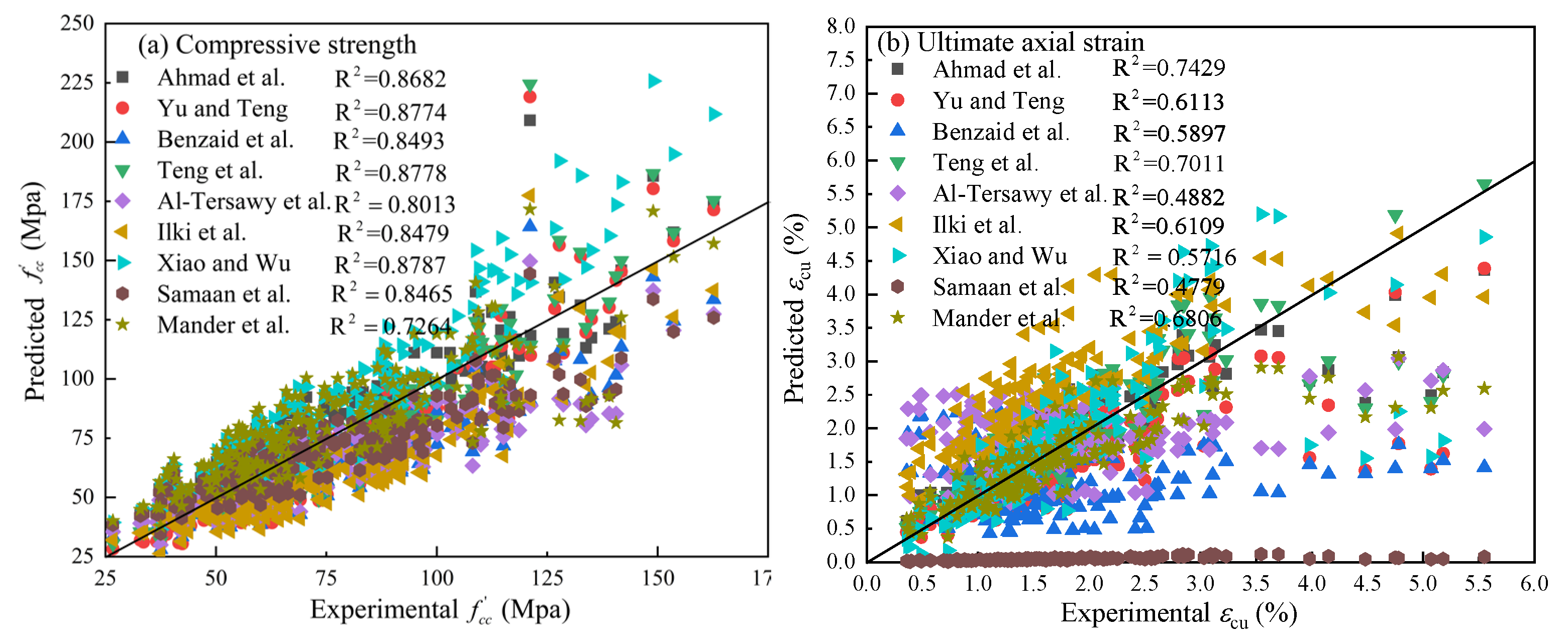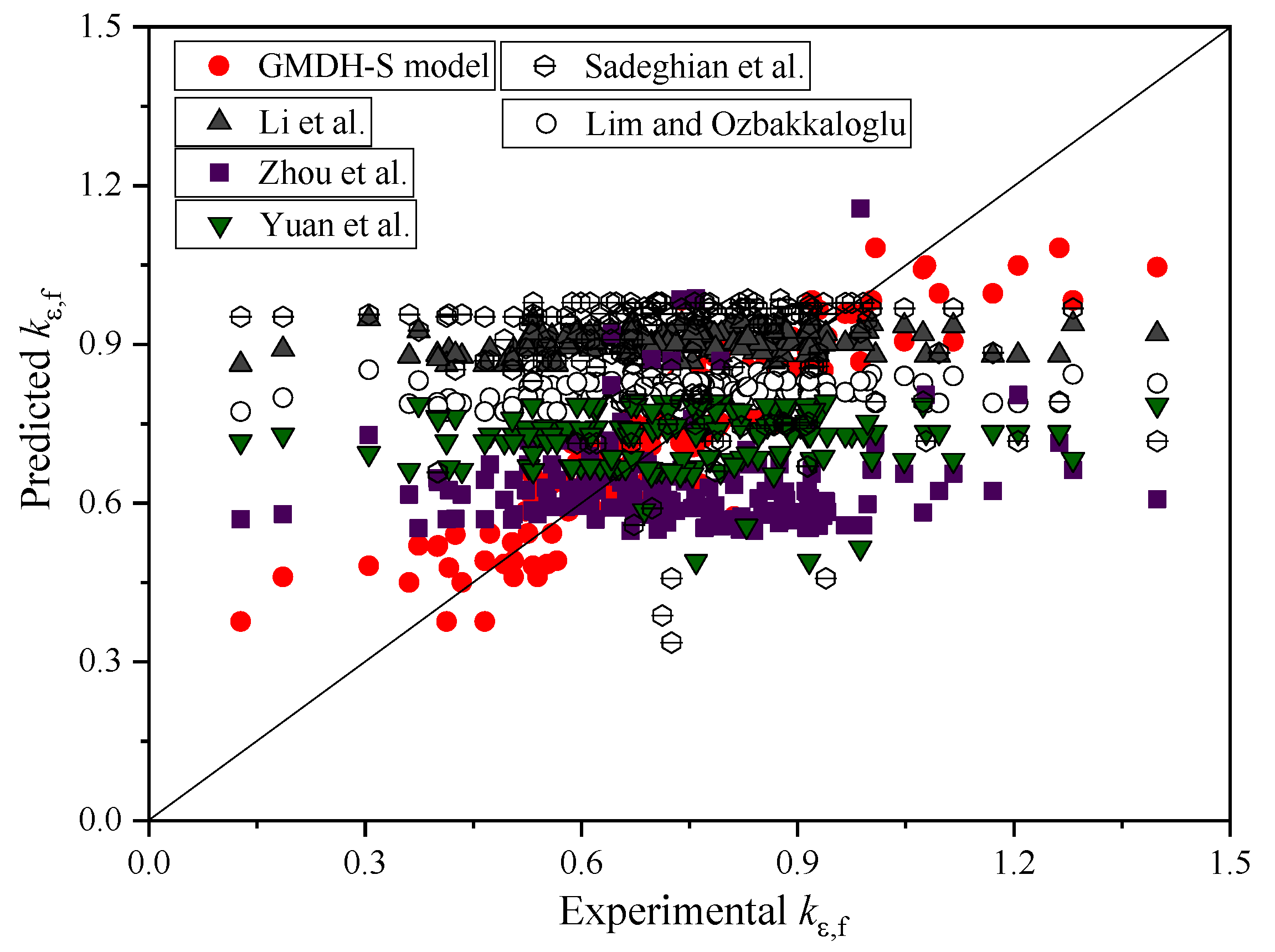Application of Group Method of Data Handling on the Ultimate Conditions’ Prediction of FRP-Confined Concrete Cylinders
Abstract
:1. Introduction
2. Group Method of Data Handling
3. Database
- (1)
- The collected parameters include: the diameter of unconfined concrete , the height of unconfined concrete , the elastic modulus of unconfined concrete , the peak strain of unconfined concrete , the peak strength of unconfined concrete , the total thickness of the FRP jacket , the elastic modulus of the FRP jacket , the hoop strain of the FRP jacket at rapture , confining stress , stiffness ratio , strain ratio , the compressive strength of FRP-confined concrete and the ultimate axial strain of FRP-confined concrete (Note: The units of parameters are shown in Figure 5). If the test values of and were not provided, to make the results more accurate, Equations (3) and (4) were adopted [50,51].
- (2)
- The height-to-diameter ratio of each specimen is less than 3 to exclude the influence of specimen slenderness.
- (3)
- The type of concrete is normal-strength concrete (NSC).
- (4)
- Only the specimens that failed due to FRP rupture at the ultimate condition are included.
- (5)
- Only the fully FRP-confined specimens are included, and the fiber direction is the hoop direction.
4. Existing Confinement Models
5. Establishment and Evaluation of the GMDH Model
5.1. Comprehensive Indicators
5.2. Selection of Input Parameters
5.3. Network Configuration
5.4. The Optimal Input Form
5.5. Comparison with Existing Models
5.6. Strain Reduction Coefficient Model
5.7. Graphical User Interface (GUI)
6. Conclusions
- (1)
- The input form has a great influence on the prediction results of the model. Therefore, the influence of the input form needs to be considered when establishing the confinement model by machine learning techniques.
- (2)
- The nine existing confinement models perform well with regards to the prediction of compressive strength and can provide an effective reference for practical applications. However, they are slightly insufficient in the prediction of ultimate axial strain, and the determination coefficients of all the models are lower than 0.75.
- (3)
- The prediction results of the GMDH model agree well with the experimental results, and the R2, COV, MAE, RMSE and MAPE values of the GMDH model are 0.974, 0.065, 3.742, 4.904 and 0.051 (compressive strength), and 0.911, 0.177, 0.208, 0.283 and 0.135 (ultimate axial strain), respectively, which are better compared to the existing confinement models.
- (4)
- The strain reduction coefficient model established based on GMDH is better than the existing literature models, and the R2, COV, MAE, RMSE and MAPE values are 0.817, 0.134, 0.066, 0.089 and 0.095, respectively.
- (5)
- The GMDH-type neural network has good application potential regarding the prediction of the ultimate conditions of FRP-confined concrete. However, a too complicated formula may affect the promotion of the GMDH model. Therefore, for practical applications, this paper developed a graphical user interface (GUI) based on Visual Basic 6.0 software, which is freely available.
- (6)
- Similar to other models based on machine learning algorithms, the GMDH model also has some limitations. The application scope of the model is limited to FRP-confined normal-strength concrete, and the values of each input parameter should be within the range of the database.
Author Contributions
Funding
Institutional Review Board Statement
Informed Consent Statement
Data Availability Statement
Conflicts of Interest
References
- Hasan, H.A.; Sheikh, M.N.; Hadi, M.N.S. Maximum axial load carrying capacity of fiber reinforced-polymer (FRP) bar reinforced concrete columns under axial compression. Structures 2019, 19, 227–233. [Google Scholar] [CrossRef]
- Zhou, Y.; Liu, X.; Xing, F.; Cui, H.; Sui, L. Axial compressive behavior of FRP-confined lightweight aggregate concrete: An experimental study and stress-strain relation model. Constr. Build. Mater. 2016, 119, 1–15. [Google Scholar] [CrossRef]
- Chen, G.M.; He, Y.H.; Jiang, T.; Lin, C.J. Behavior of CFRP-confined recycled aggregate concrete under axial compression. Constr. Build. Mater. 2016, 111, 85–97. [Google Scholar] [CrossRef]
- Mander, J.B.; Priestley, M.J.N.; Park, R. Theoretical stress-strain model for confined concrete. J. Struct. Eng. 1988, 114, 1804–1826. [Google Scholar] [CrossRef]
- Guler, S. Axial behavior of FRP-wrapped circular ultra-high performance concrete specimens. Struct. Eng. Mech. 2014, 50, 709–722. [Google Scholar] [CrossRef]
- Benzaid, R.; Mesbah, H.; Chikh, N.E. FRP-confined concrete cylinders: Axial compression experiments and strength model. J. Reinf. Plast. Compos. 2010, 29, 2469–2488. [Google Scholar] [CrossRef]
- Naderpour, N.; Nagai, K.; Fakharian, P.; Haji, M. Innovative models for prediction of compressive strength of FRP-confined circular reinforced concrete columns using soft computing methods. Compos. Struct. 2019, 215, 69–84. [Google Scholar] [CrossRef]
- Zhao, J.L.; Yu, T.; Teng, J.G. Stress-strain behavior of FRP-confined recycled aggregate concrete. J. Compos. Constr. 2014, 19, 4014–4054. [Google Scholar] [CrossRef]
- Teng, J.G.; Jiang, T.; Lam, L.; Luo, Y.Z. Refinement of a design-oriented stress-strain model for FRP-confined concrete. J. Compos. Constr. 2009, 13, 269–278. [Google Scholar] [CrossRef]
- Ahmad, A.; Plevris, V.; Khan, Q.U.Z. Prediction of properties of FRP-confined concrete cylinders based on artificial neural networks. Crystals 2020, 10, 811. [Google Scholar] [CrossRef]
- Yu, T.; Teng, J.G. Design of concrete-filled FRP tubular columns: Provisions in the Chinese technical code for infrastructure application of FRP composites. J. Compos. Constr. 2010, 15, 451–461. [Google Scholar] [CrossRef]
- Fan, X.L.; Wu, Z.M.; Wu, Y.F.; Zheng, J.J. FRP-confined Concrete Cylinders: Axial Compression Experiments and Strength Model. Comput. Concr. 2013, 12, 499–518. [Google Scholar] [CrossRef]
- Spoelstra, M.R.; Monti, G. FRP-confined concrete model. J. Compos. Constr. 1999, 33, 143–150. [Google Scholar] [CrossRef]
- Realfonzo, R.; Napoli, A. Concrete confined by FRP systems: Confinement efficiency and design strength models. Compos. Plan B Eng. 2011, 42, 736–755. [Google Scholar] [CrossRef]
- Khorramian, K.; Sadeghian, P. New mechanics-based confinement model and stress–strain relationship for analysis and design of concrete columns wrapped with FRP composites. Structures 2021, 33, 2659–2674. [Google Scholar] [CrossRef]
- Cardellicchio, A.; Ruggieri, S.; Leggieri, V.; Uva, G. View VULMA: Data set for training a machine-learning tool for a fast vulnerability analysis of existing buildings. Data 2022, 7, 4. [Google Scholar] [CrossRef]
- Ruggieri, S.; Cardellicchio, A.; Leggieri, V.; Uva, G. Machine-learning based vulnerability analysis of existing buildings. Autom. Constr. 2021, 132, 103936. [Google Scholar] [CrossRef]
- Sun, H.; Burton, H.V.; Huang, H. Machine learning applications for building structural design and performance assessment: State-of-the-art review. J. Build. Eng. 2020, 33, 101816. [Google Scholar] [CrossRef]
- Keshtegar, B.; Sadeghian, P.; Gholampour, A.; Ozbakkaloglu, T. Nonlinear modeling of ultimate strength and strain of FRP-confined concrete using chaos control method. Compos. Struct. 2017, 163, 423–431. [Google Scholar] [CrossRef]
- Jawdhari, A.; Hadhood, A.; Fam, A. Confinement model for FRP-wrapped circular columns when the wraps are subjected to damage. Constr. Build. Mater. 2021, 275, 122101. [Google Scholar] [CrossRef]
- Sadeghian, P.; Fam, A. Improved design-oriented confinement models for FRP-wrapped concrete cylinders based on statistical analyses. Eng. Struct. 2015, 87, 162–182. [Google Scholar] [CrossRef]
- Mansouri, I.; Ozbakkaloglu, T.; Kisi, O.; Xie, T. Predicting behavior of FRP-confined concrete using neuro fuzzy, neural network, multivariate adaptive regression splines and M5 model tree techniques. Mater. Struct. 2016, 49, 4319–4334. [Google Scholar] [CrossRef]
- Cevik, A.; Cabalar, A.F. A genetic-programming-based formulation for the strength enhancement of fiber-reinforced-polymer-confined concrete cylinders. J. Appl. Polym. Sci. 2008, 110, 3087–3095. [Google Scholar] [CrossRef]
- Cevik, A.; Göğüş, M.T.; Güzelbey, İ.H.; Filiz, H. Soft computing based formulation for strength enhancement of CFRP confined concrete cylinders. Adv. Eng. Softw. 2010, 41, 527–536. [Google Scholar] [CrossRef]
- Gandomi, A.H.; Alavi, A.H.; Sahab, M.G. New formulation for compressive strength of CFRP confined concrete cylinders using linear genetic programming. Mater. Struct. 2010, 43, 963–983. [Google Scholar] [CrossRef]
- Jiang, T.; Teng, J.G. Analysis-oriented models for FRP confined concrete: A comparative assessment. Eng. Struct. 2007, 29, 2968–2986. [Google Scholar] [CrossRef]
- Lam, L.; Teng, J.G. Ultimate condition of fiber reinforced polymer-confined concrete. J. Compos. Constr. 2004, 8, 539–548. [Google Scholar] [CrossRef]
- Lam, L.; Teng, J.G.; Cheung, C.H.; Xiao, Y. FRP-confined concrete under axial cyclic compression. Cem. Concr. Compos. 2006, 28, 949–958. [Google Scholar] [CrossRef]
- Teng, J.G.; Yu, T.; Wong, Y.L.; Dong, S.L. Hybrid FRP-concrete–steel tubular columns: Concept and behaviour. Constr. Build. Mater. 2007, 21, 846–854. [Google Scholar] [CrossRef]
- Saadatmanesh, H.; Ehsani, M.R.; Li, M.W. Strength and ductility of concrete columns externally reinforced with fiber composite straps. ACI Struct. J. 1994, 91, 434–447. [Google Scholar]
- Xiao, Y.; Wu, H. Compressive behavior of concrete confined by carbon fiber composite jackets. J. Mater. Civ. Eng. 2000, 12, 139–146. [Google Scholar] [CrossRef]
- Picher, F.; Rochette, P.; Labossiere, P. Confinement of concrete cylinders with CFRP. In Proceedings of the First International Conference on Composites for Infrastructures, Tucson, AZ, USA, 15–17 January 1996; University of Arizona: Tucson, AZ, USA, 1996. [Google Scholar]
- Watanable, K.; Nakamura, H.; Honda, T.; Toyoshima, M.; Iso, M.; Fujimaki, T. Confinement effect of FRP sheet on strength and ductility of concrete cylinders under uniaxial compression. In Proceedings of the Third International Symposium on Non-Metallic (FRP) Reinforcement for Concrete Structures, Sapporo, Japan, 14–16 October 1997. [Google Scholar]
- Matthys, S.; Taerwe, L.; Audenaert, K. Tests on axially loaded concrete columns confined by fiber reinforced polymer sheet wrapping. In Proceedings of the Fourth International Symposium on Fiber Reinforced Polymer Reinforcement for Reinforced Concrete Structures, Farmington Hills, MI, USA, 31 October–5 November 1999; American Concrete Institute: Farmington Hills, MI, USA, 1999. [Google Scholar]
- Rochette, P.; Labossiere, P. Axial testing of rectangular column models confined with composites. J. Compos. Constr. 2000, 4, 129–136. [Google Scholar] [CrossRef]
- Aire, C.; Gettu, R.; Casas, J.R. Study of the compressive behavior of concrete confined by fiber reinforced composites. In Proceedings of the International Conference on Composites in Construction, Porto, Portugal, 10–12 October 2001; AA Balkema Publishers: Lisse, The Netherlands, 2001. [Google Scholar]
- Dias, D.S.V.; Santos, J.M.C. Strengthening of axially loaded concrete cylinders by surface composites. In Proceedings of the International Conference on Composites in Construction, Porto, Portugal, 10–12 October 2001; AA Balkema Publishers: Lisse, The Netherlands, 2001. [Google Scholar]
- Micelli, F.; Myers, J.J.; Murthy, S. Effect of environmental cycles on concrete cylinders confined with FRP. In Proceedings of the International Conference on Composites in Construction, Porto, Portugal, 10–12 October 2001; AA Balkema Publishers: Lisse, The Netherlands, 2001. [Google Scholar]
- Pessiki, S.; Harries, K.A.; Kestner, J.T.; Sause, R.; Ricles, J.M. Axial behavior of reinforced concrete columns confined with FRP jackets. J. Compos. Constr. 2001, 5, 237–245. [Google Scholar] [CrossRef]
- Wang, P.; Cheong, K.K. RC columns strengthened by FRP under uniaxial compression. In Proceedings of the International Conference on FRP Composites in Civil Engineering, Hong Kong, China, 12–15 December 2001; Elsevier: Oxford, UK, 2001. [Google Scholar]
- Lorenzis, D.L.; Micelli, F.; La, T.A. Influence of specimen size and resin type on the behavior of FRP-confined concrete cylinders. In Proceedings of the First International Conference on Advanced Polymer Composites for Structural Applications in Construction, Southampton, UK, 15–17 April 2002; Thomas Telford: London, UK, 2002. [Google Scholar]
- Shehata, I.A.E.M.; Carneiro, L.A.V.; Shehata, L.C.D. Strength of short concrete columns confined with CFRP sheets. Mater. Struct. 2002, 35, 50–58. [Google Scholar] [CrossRef]
- Wang, W.; Wu, C.; Liu, Z.; Si, H. Compressive behavior of ultra-high performance fiber reinforced concrete (UHPFRC) confined with FRP. Compos. Struct. 2018, 204, 419–437. [Google Scholar] [CrossRef]
- Cui, C.; Sheikh, S.A. Experimental study of normal-and high-strength concrete confined with fiber-reinforced polymers. J. Compos. Constr. 2010, 14, 553–561. [Google Scholar] [CrossRef]
- Ozbakkaloglu, T.; Lim, J.C. Axial compressive behavior of FRP-confined concrete: Experimental test database and a new design-oriented model. Compos. Part B Eng. 2013, 55, 607–634. [Google Scholar] [CrossRef]
- Ivakhnenko, A.G.; Ivaknenko, G.A. The review of problems solvable by algorithms of the group method of data handling (GMDH). Pattern Recognit. 1995, 5, 527–535. [Google Scholar]
- Hossein, R.; Rahmat, M.; Hassan, A. Point-load test and UPV for compressive strength prediction of recycled coarse aggregate concrete via generalized GMDH-class neural network. Constr. Build. Mater. 2021, 276, 122–143. [Google Scholar]
- Rahmat, M.; John, H.B.; Reza, G. Prediction of the concrete compressive strength by means of core testing using GMDH-type neural network and ANFIS models. Comput. Mater. Sci. 2012, 51, 261–272. [Google Scholar]
- Farlow, S.J. Self-Organizing Method in Modelling: GMDH Type Algorithms; Marcel-Dekker Inc.: New York, NY, USA, 1984; pp. 1–24. [Google Scholar]
- American Concrete Institute (ACI). Guide for the Design and Construction of Externally Bonded FRP Systems for Strengthening Concrete Structures; ACI-440 2R: Farmington Hills, MI, USA, 2008. [Google Scholar]
- Popovics, S. Numerical approach to the complete stress-strain relation for concrete. Cem. Concr. Res. 1973, 3, 583–599. [Google Scholar] [CrossRef]
- Al-Tersawy, S.H.; Hodhod, O.A.; Hefn-Awy, A.A. Reliability and code calibration of RC short columns confined with CFRP wraps. In Proceedings of the 8th International Symposium on Fiber Reinforced Polymer Reinforcement for Reinforced Concrete Structures, Patras, Greece, 16–18 July 2007; University of Patras: Patras, Greece, 2007. [Google Scholar]
- Ilki, A.; Kumbasar, N.; Koc, V. Low strength concrete members externally confined with FRP sheets. Struct. Eng. Mech. 2004, 18, 167–194. [Google Scholar] [CrossRef]
- Samaan, M.; Mirmiran, A.; Shahawy, M. Model of concrete confined by fiber compo-sites. J. Struct. Eng. 1998, 124, 1025–1031. [Google Scholar] [CrossRef]
- Ma, G.; Liu, K. Prediction of compressive strength of CFRP-confined concrete columns based on BP neural network. J. Hunan Univ. 2021, 48, 88–97. [Google Scholar]
- Smith, S.T.; Kim, S.J.; Zhang, H.W. Behavior and effectiveness of FRP wrap in the confinement of large concrete cylinders. J. Compos. Constr. 2010, 14, 573–582. [Google Scholar] [CrossRef]
- Chen, J.F.; Li, S.Q.; Bisby, L.A.; Ai, J. FRP rupture strains in the split-disk test. Compos. Part B Eng. 2011, 42, 962–972. [Google Scholar] [CrossRef]
- Sadeghian, P.; Fillmore, B. Strain distribution of basalt FRP-wrapped concrete cylinders. Case Stud. Constr. Mater. 2018, 9, e00171. [Google Scholar] [CrossRef]
- Sadeghian, P.; Seracino, R.; Das, B.; Lucier, G. Influence of geometry and fiber properties on rupture strain of cylindrical FRP jackets under internal ICE pressure. Compos. Struct. 2018, 192, 173–183. [Google Scholar] [CrossRef]
- Lim, J.C.; Ozbakkaloglu, T. Confinement model for FRP-confined high-strength concrete. J. Compos. Constr. 2014, 18, 04013058. [Google Scholar] [CrossRef]
- Li, P.; Wu, Y.F.; Gravina, R. Cyclic response of FRP-confined concrete with post-peak strain softening behavior. Constr. Build. Mater. 2016, 123, 814–828. [Google Scholar] [CrossRef]
- Zhou, Y.; Zheng, Y.; Sui, L. Behavior and modeling of FRP-confined ultra-light weight cement composites under monotonic axial compression. Compos. Part B Eng. 2019, 162, 289–302. [Google Scholar] [CrossRef]
- Yuan, W.; Han, Q.; Bai, Y.; Du, X.; Liu, Q.L. A unified confinement model of FRP-wrapped concrete cylinder. China J. Highw. Transp. 2022, 35, 146–158. [Google Scholar]
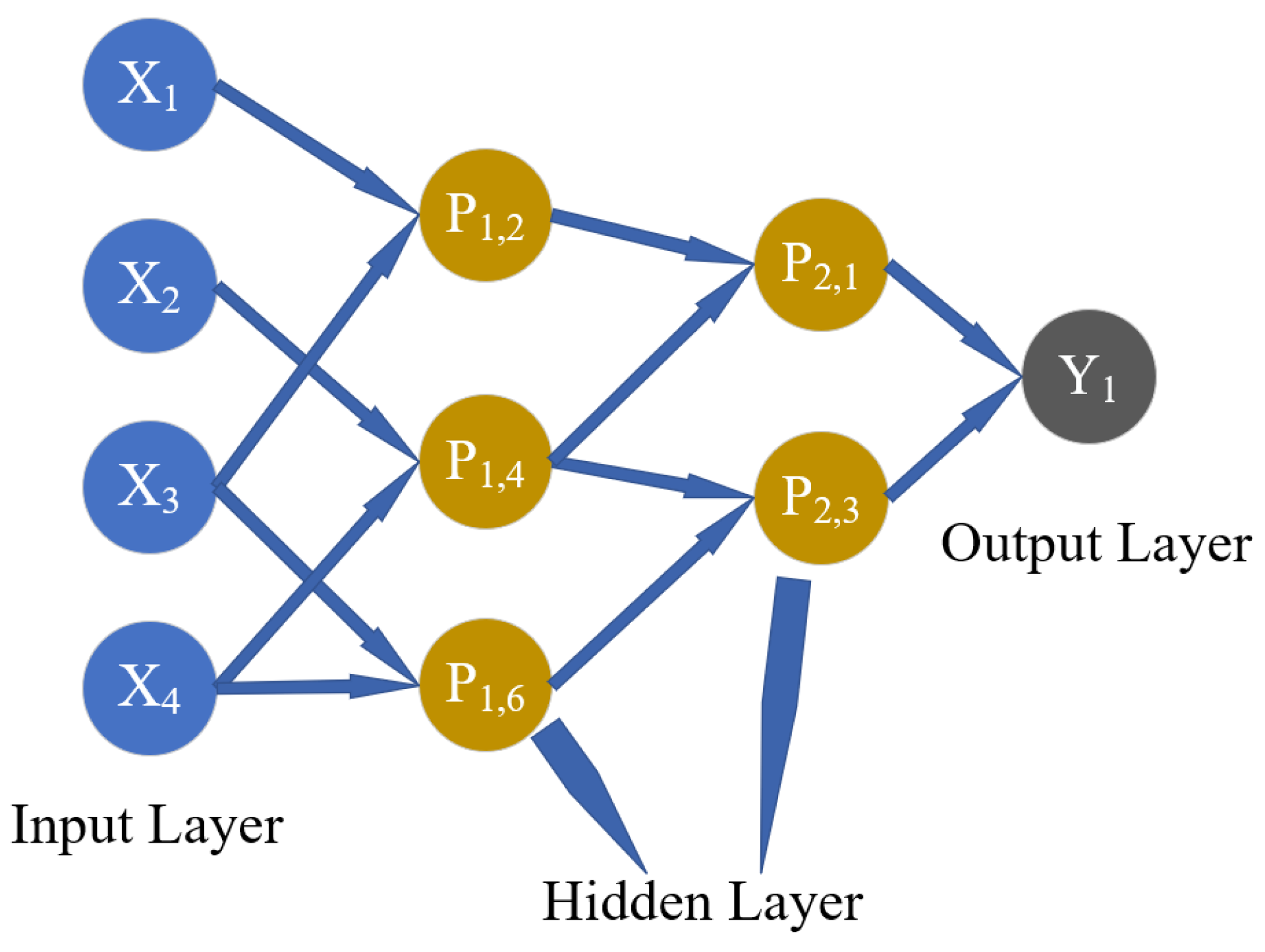
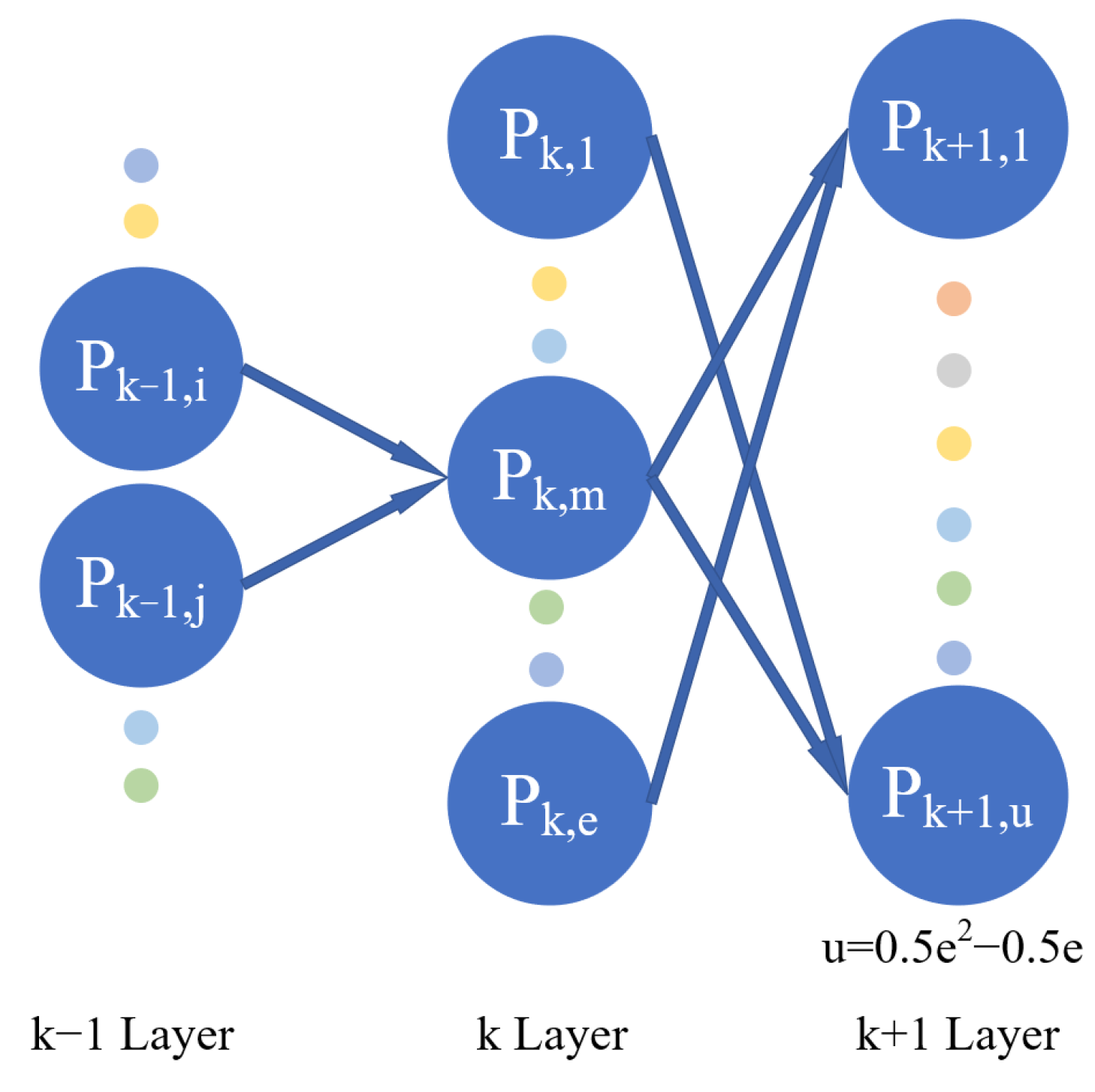




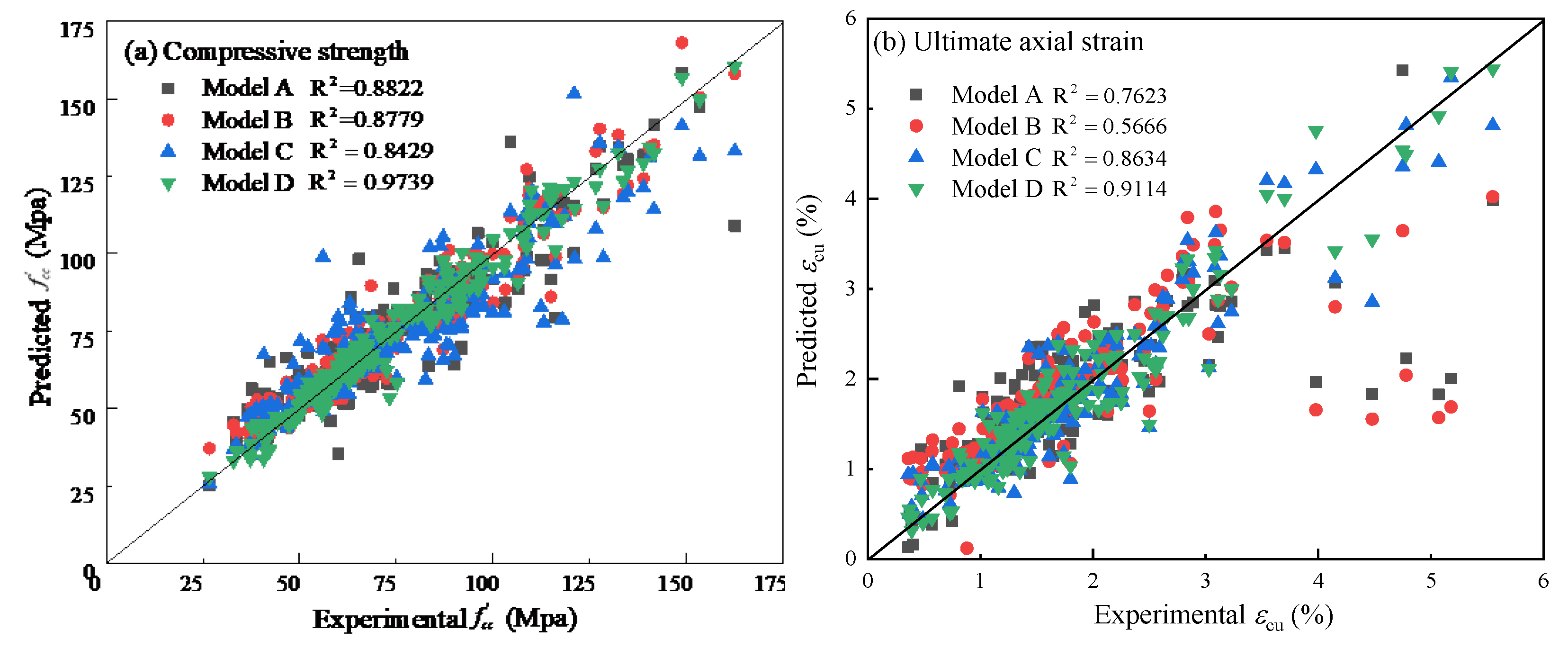
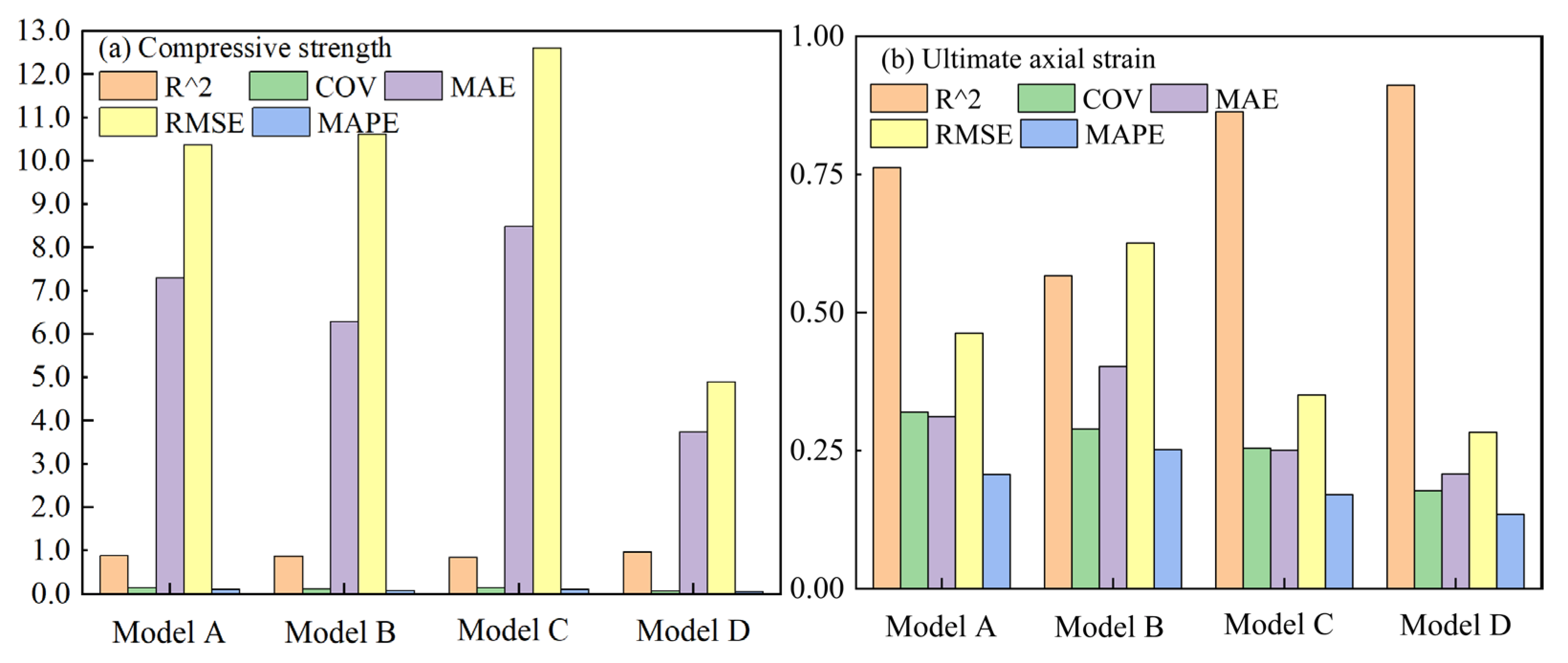
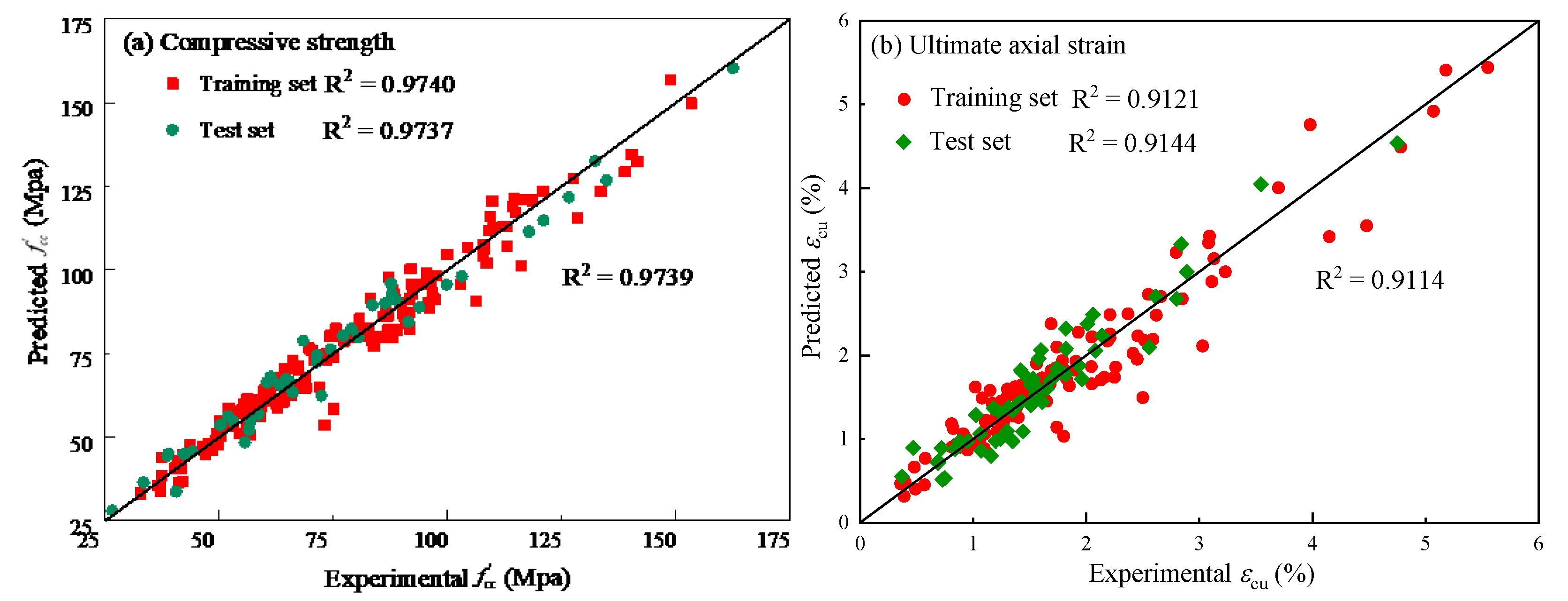
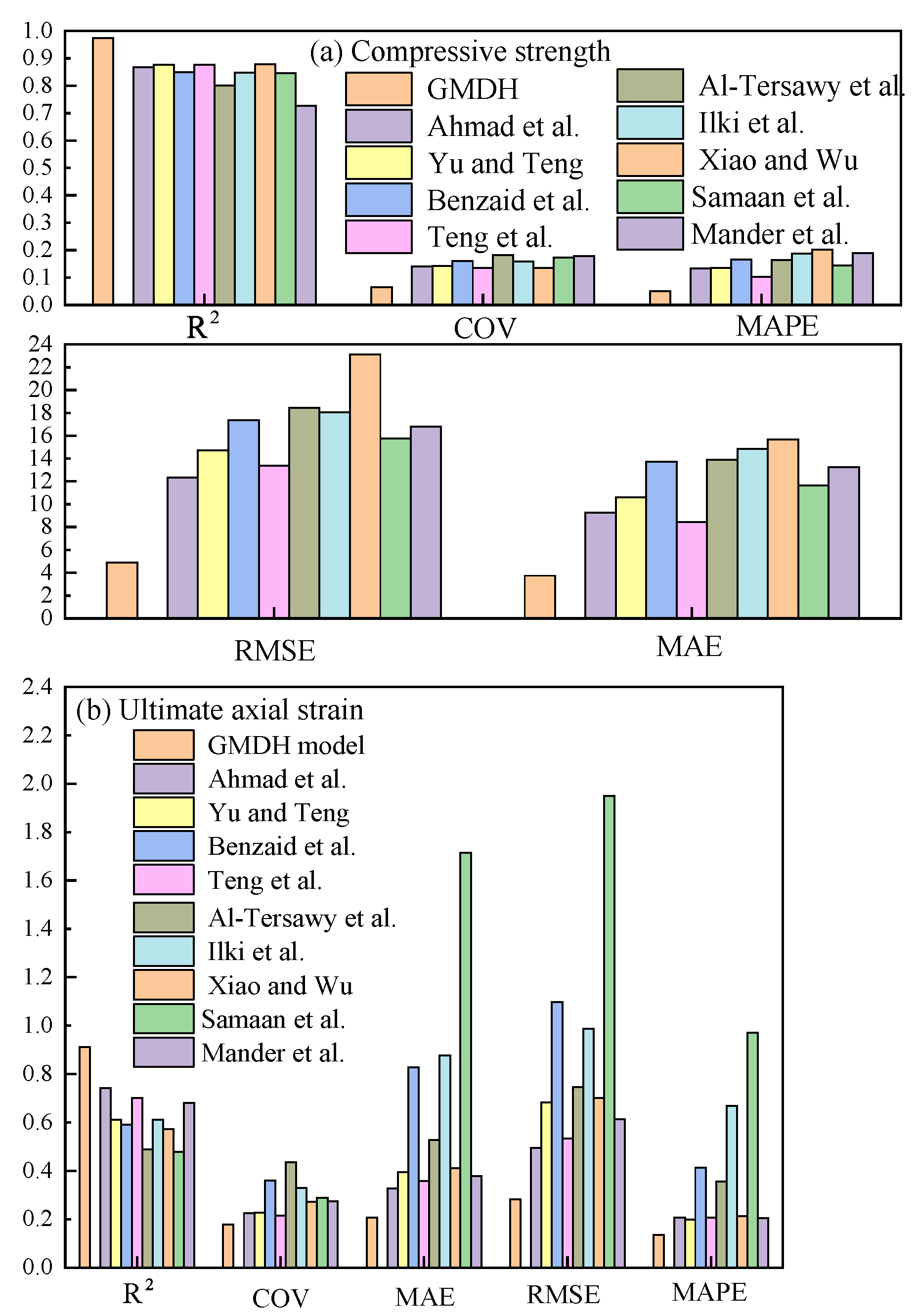

| Parameters | Parameters | ||||
|---|---|---|---|---|---|
| D | 0.112 | −0.121 | 0.006 | 0.377 # | |
| H | −0.104 | −0.127 | 0.928 # | 0.653 # | |
| 0.320 # | −0.029 | 0.598 # | 0.378 # | ||
| 0.012 | 0.237 # | 0.023 | 0.301 # | ||
| 0.303 # | −0.003 | 1 | 0.676 # | ||
| 0.563 # | 0.305 # | 0.676 # | 1 | ||
| −0.101 | −0.169 * |
| Model and Year | Compressive Strength | Ultimate Axial Strain |
|---|---|---|
| Ahmad et al. [10] 2020 | ||
| Yu and Teng [11] 2011 | ||
| Benzaid et al. [6] 2010 | ||
| Teng et al. [9] 2009 | ||
| Al-Tersawy et al. [52] 2007 | ||
| Ilki et al. [53] 2004 | ||
| Xiao and Wu [31] 2000 | ||
| Samaan et al. [54] 1998 | ||
| Mander et al. [4] 1988 | ||
| Model | ||
|---|---|---|
| A | ||
| B | ||
| C | ||
| D | ||
| Model | Year | Equation |
|---|---|---|
| Sadeghian et al. [59] | 2018 | |
| Lim and Ozbakkaloglu [60] | 2014 | |
| Li et al. [61] | 2016 | |
| Zhou et al. [62] | 2019 | |
| Yuan et al. [63] | 2021 |
| Model | R2 | COV | MAE | RMSE | MAPE |
|---|---|---|---|---|---|
| GMDH-S model | 0.817 | 0.134 | 0.066 | 0.089 | 0.095 |
| Sadeghian et al. [59] | 0.007 | 0.526 | 0.227 | 0.277 | 0.413 |
| Lim and Ozbakkaloglu [60] | 0.046 | 0.457 | 0.165 | 0.208 | 0.302 |
| Li et al. [61] | 0.049 | 0.457 | 0.207 | 0.255 | 0.387 |
| Zhou et al. [62] | 0.002 | 0.452 | 0.191 | 0.237 | 0.275 |
| Yuan et al. [63] | 0.002 | 0.476 | 0.159 | 0.204 | 0.266 |
Publisher’s Note: MDPI stays neutral with regard to jurisdictional claims in published maps and institutional affiliations. |
© 2022 by the authors. Licensee MDPI, Basel, Switzerland. This article is an open access article distributed under the terms and conditions of the Creative Commons Attribution (CC BY) license (https://creativecommons.org/licenses/by/4.0/).
Share and Cite
Deng, C.; Zhang, R.; Xue, X. Application of Group Method of Data Handling on the Ultimate Conditions’ Prediction of FRP-Confined Concrete Cylinders. Polymers 2022, 14, 3615. https://doi.org/10.3390/polym14173615
Deng C, Zhang R, Xue X. Application of Group Method of Data Handling on the Ultimate Conditions’ Prediction of FRP-Confined Concrete Cylinders. Polymers. 2022; 14(17):3615. https://doi.org/10.3390/polym14173615
Chicago/Turabian StyleDeng, Chubing, Ruiliang Zhang, and Xinhua Xue. 2022. "Application of Group Method of Data Handling on the Ultimate Conditions’ Prediction of FRP-Confined Concrete Cylinders" Polymers 14, no. 17: 3615. https://doi.org/10.3390/polym14173615
APA StyleDeng, C., Zhang, R., & Xue, X. (2022). Application of Group Method of Data Handling on the Ultimate Conditions’ Prediction of FRP-Confined Concrete Cylinders. Polymers, 14(17), 3615. https://doi.org/10.3390/polym14173615






